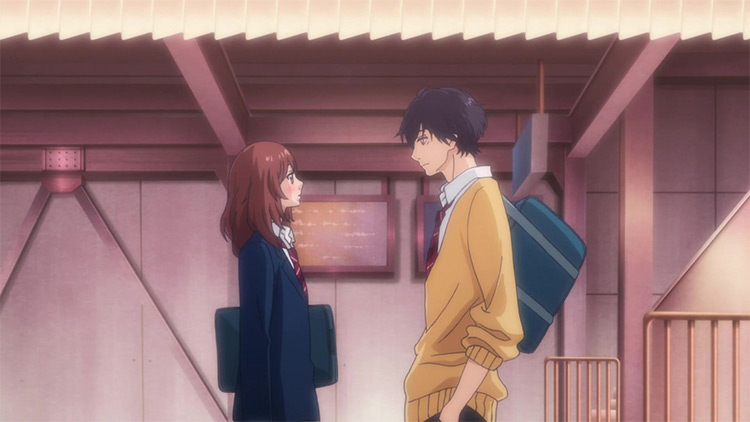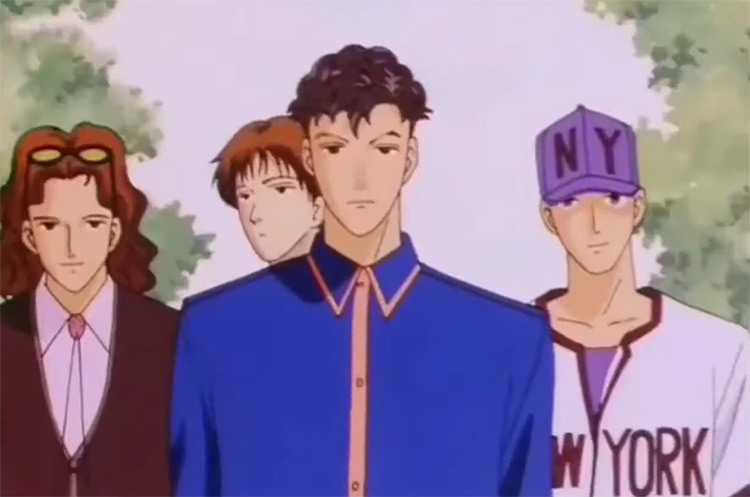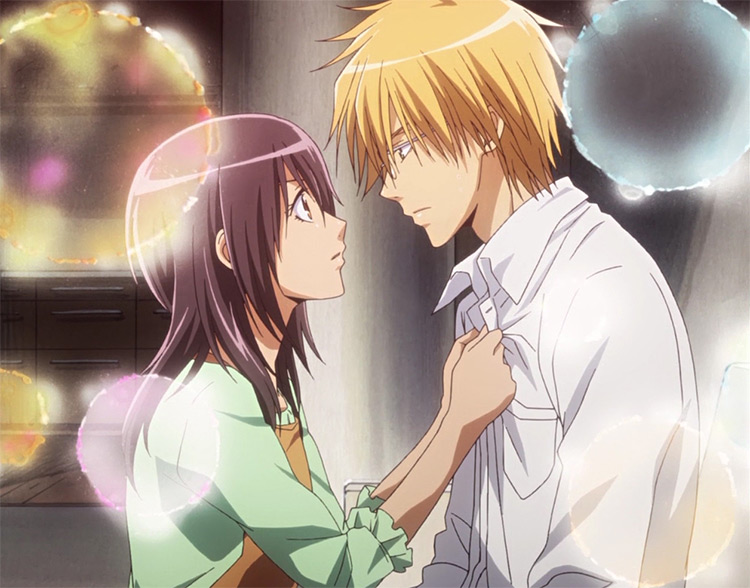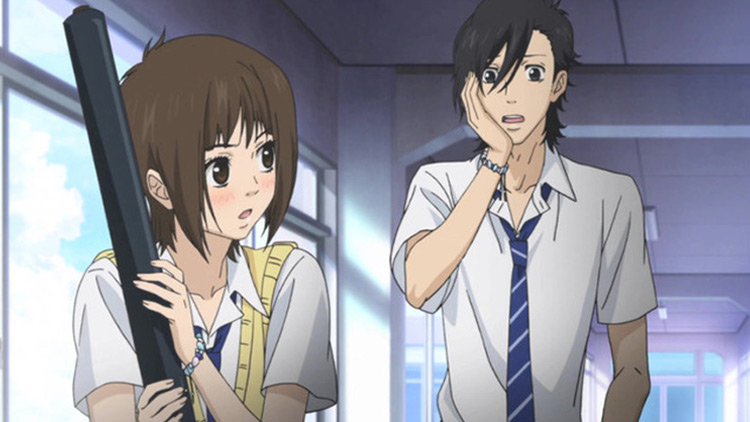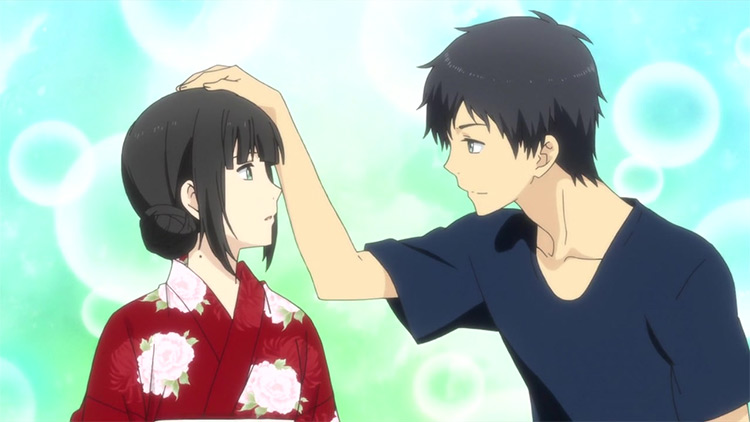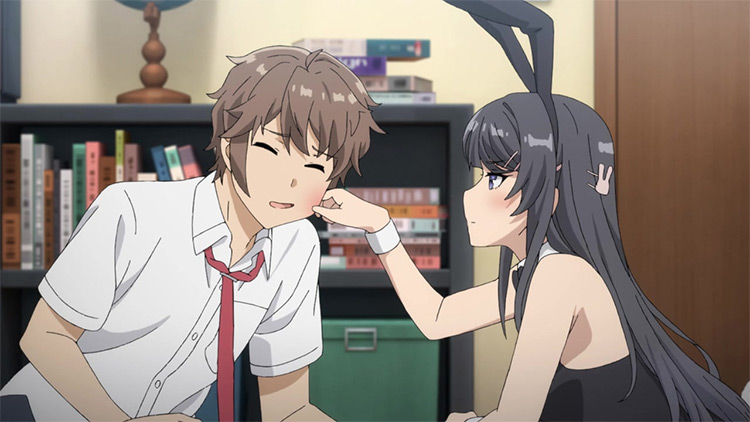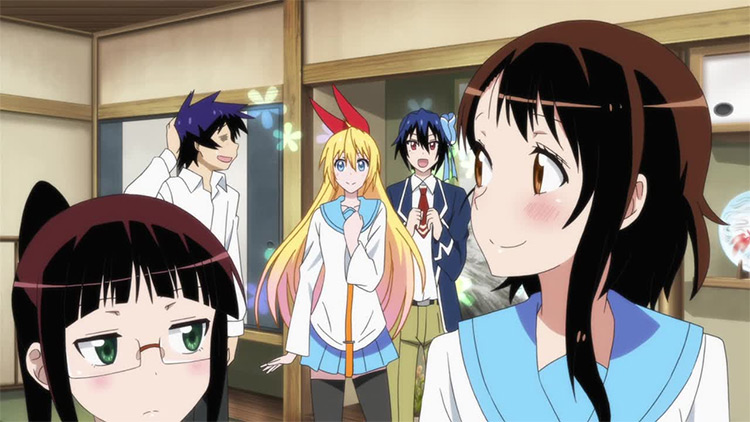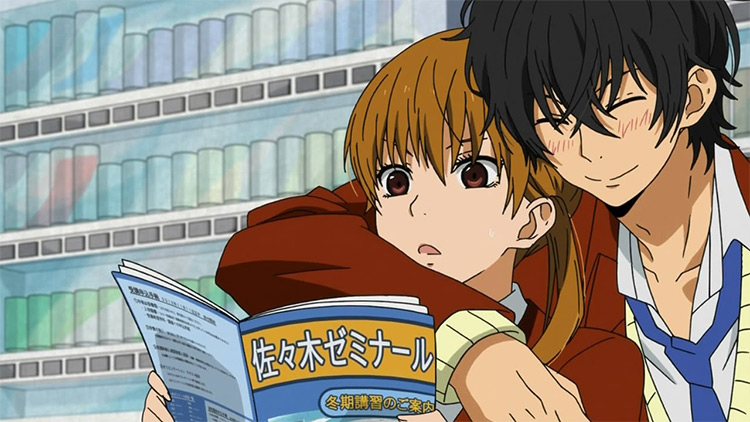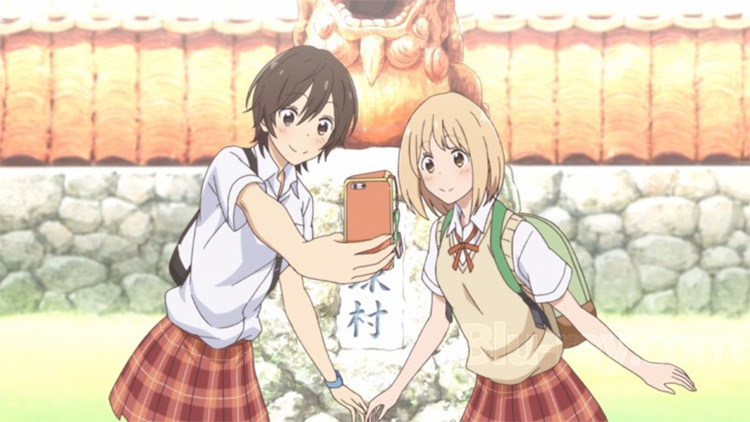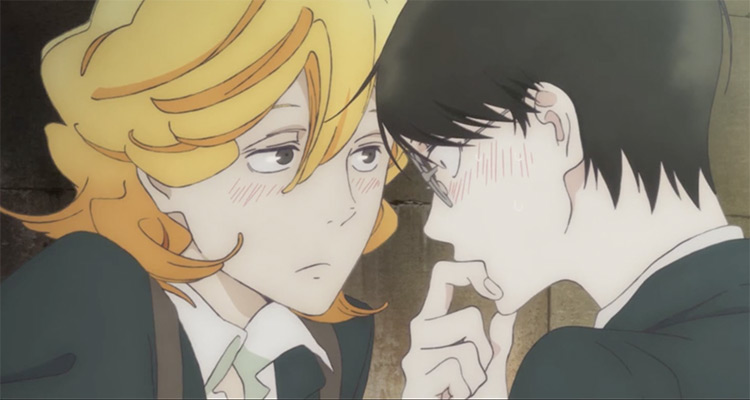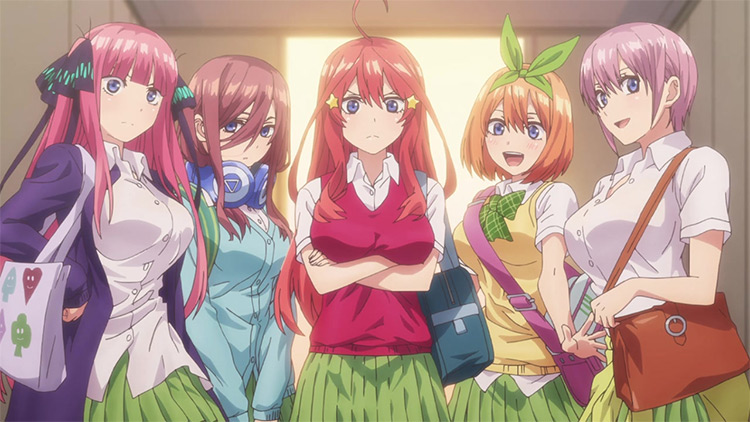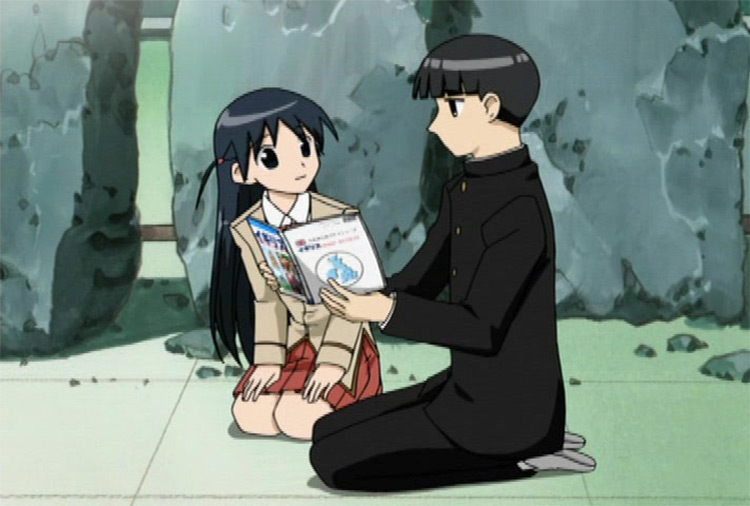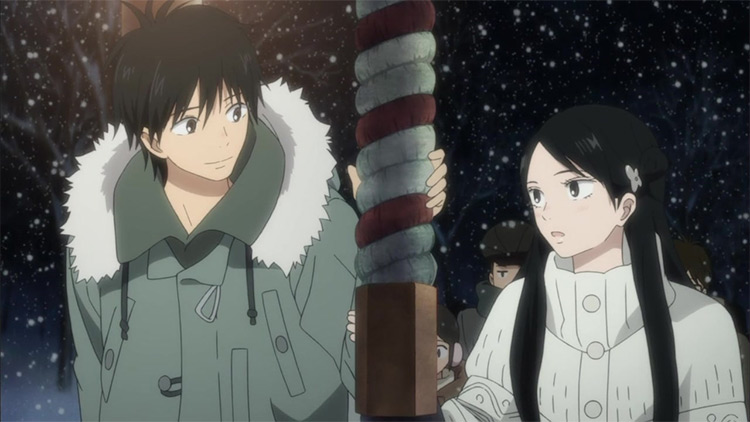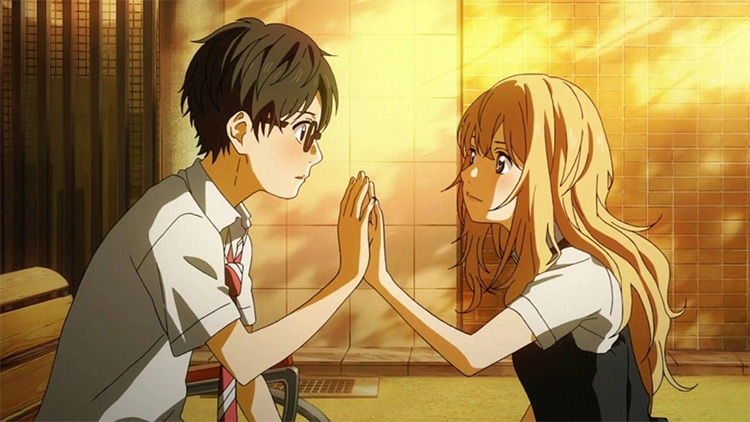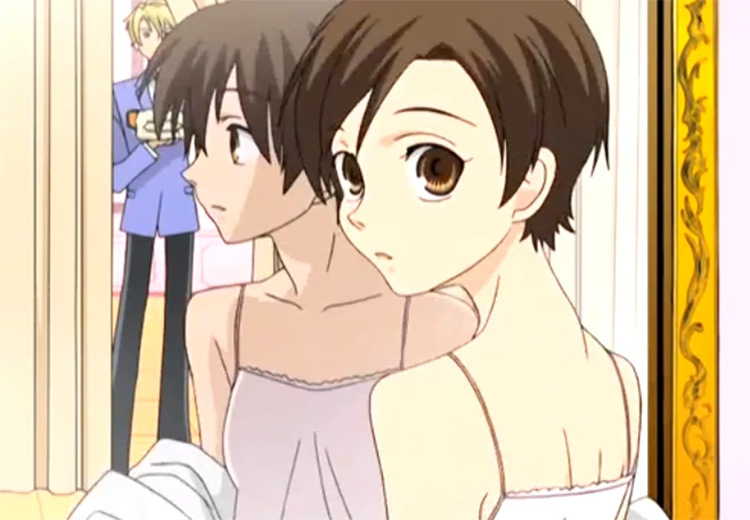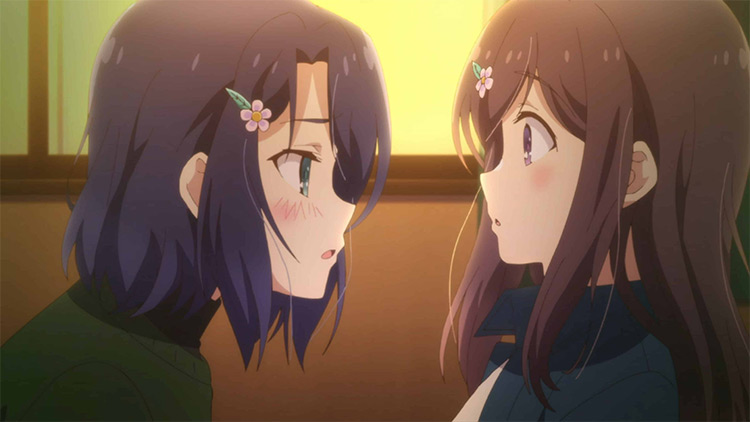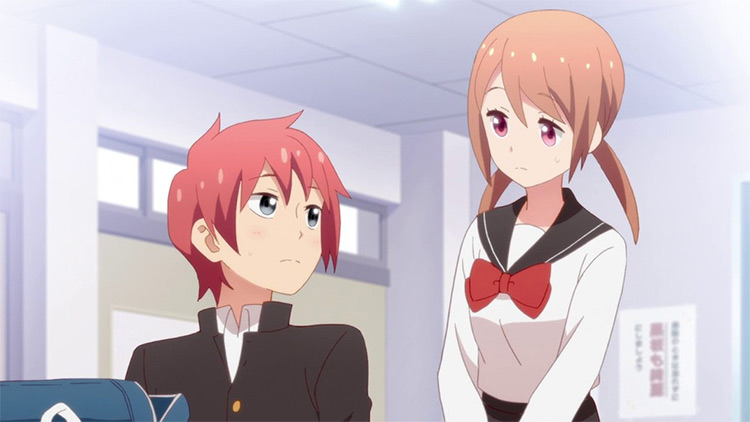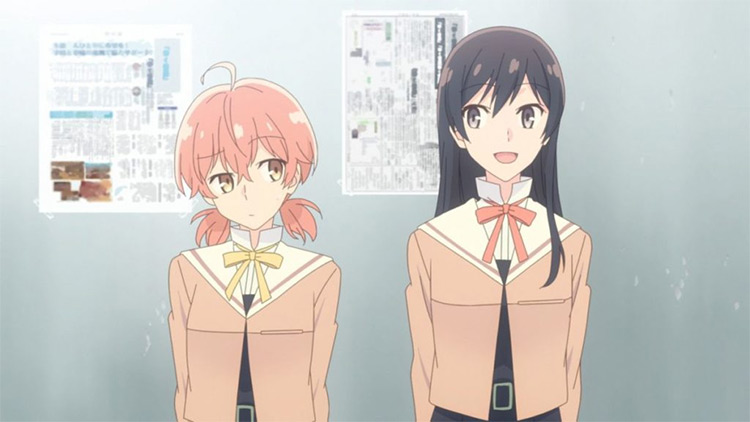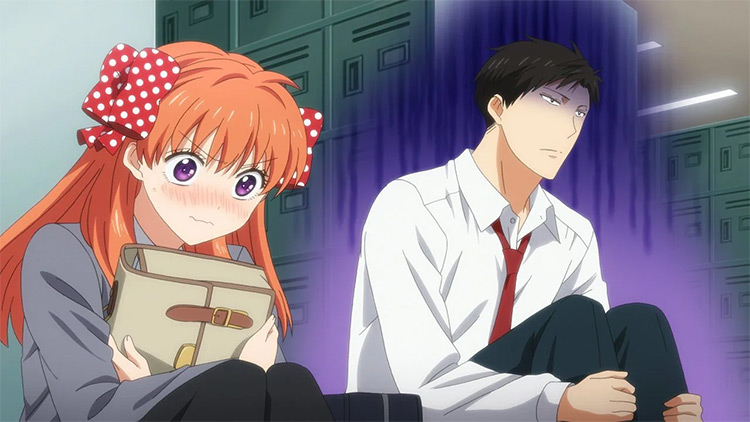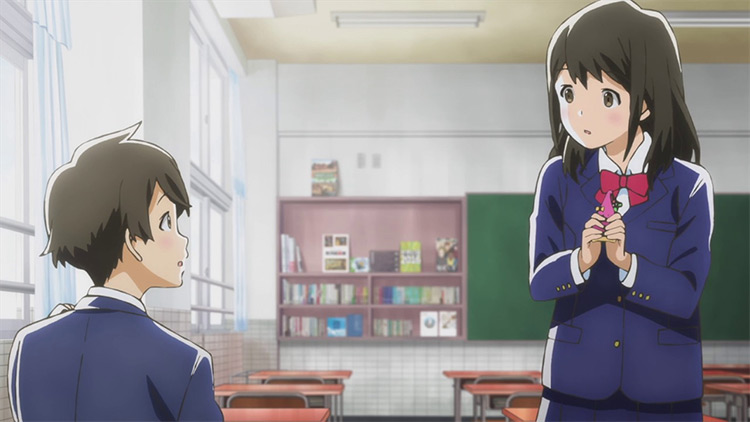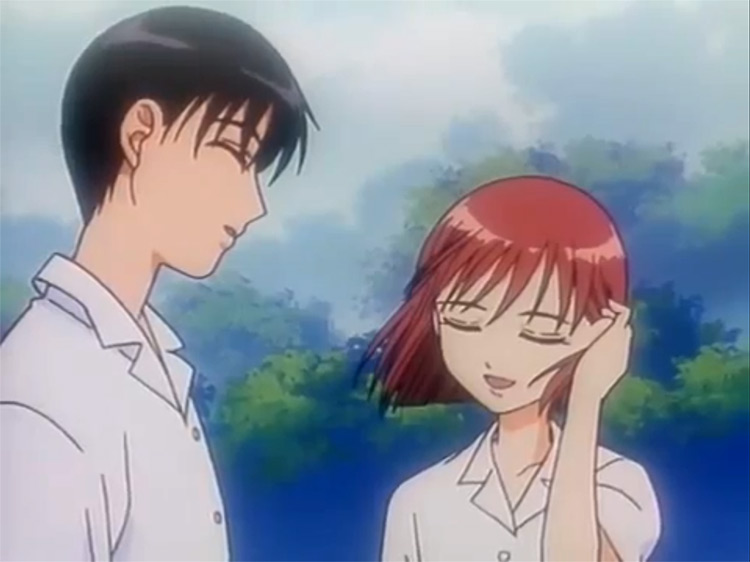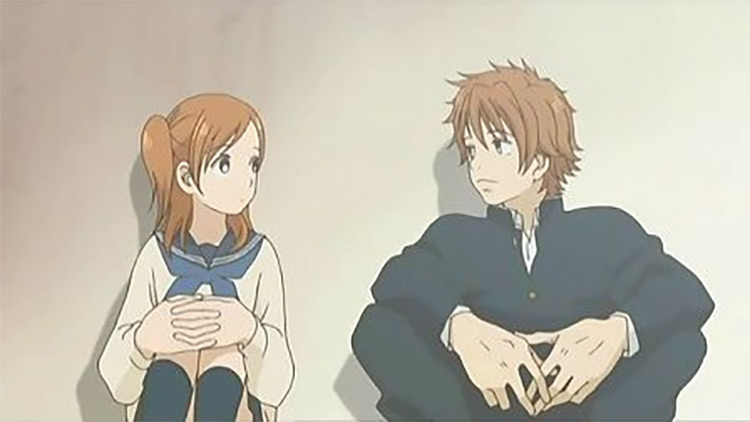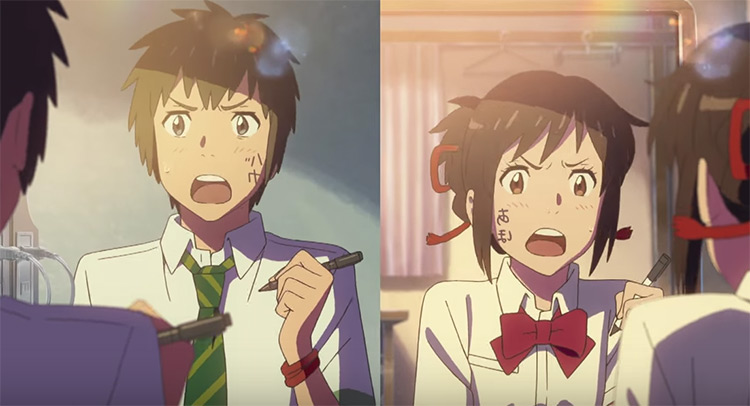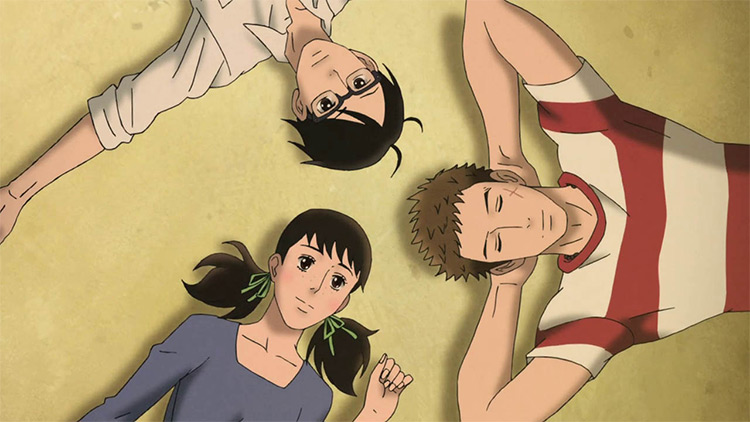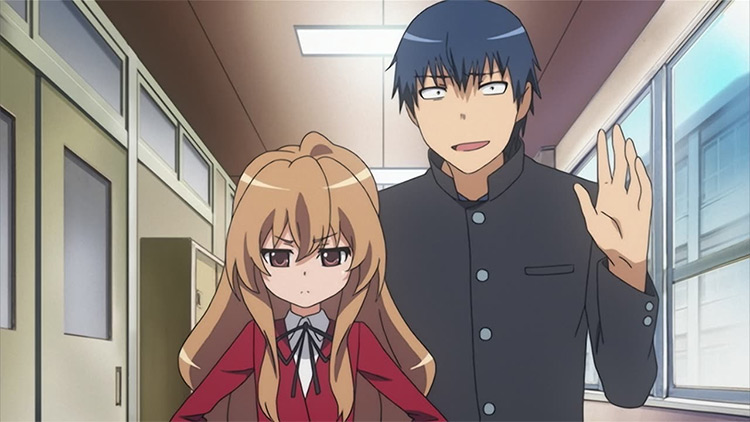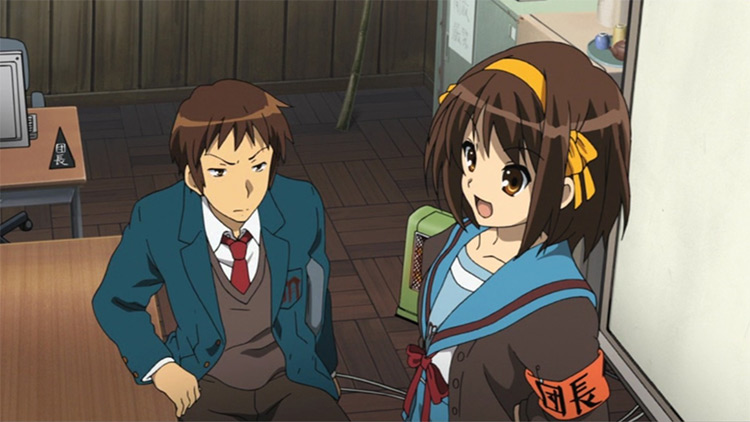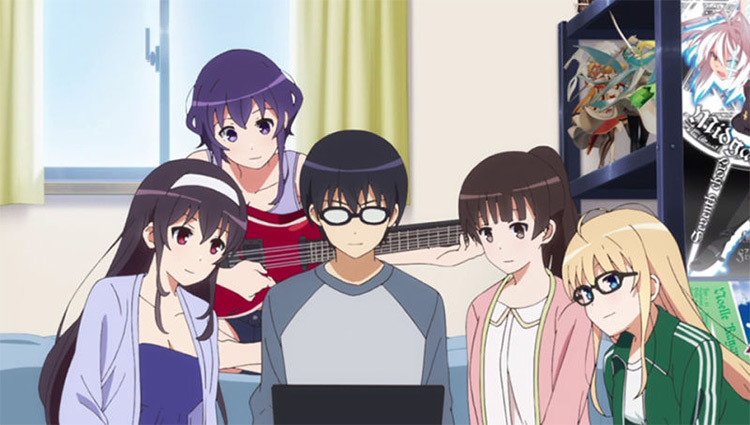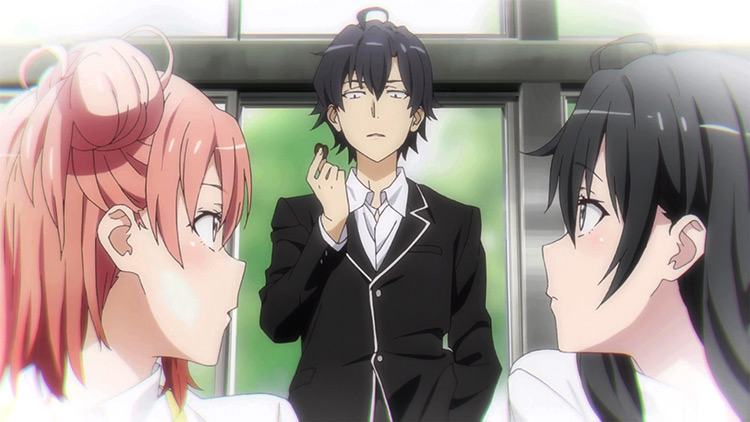Just like battle shounen series brimming with super-powered guys and increasingly powerful villains, HS romance anime have been a mainstay in both TV and movie landscapes for decades. Some people think that this type of romance anime has run out of ideas — and I understand why they think that way. Similar to other genres, it has a large chunk of mediocre projects that have cookie-cutter characters and derivative plot development. Yet the very best ones can leave a lasting impression, ensuring future anime fans will want to watch them too. With that in mind, here are my all-time favorite romance anime TV series & films featuring high school students.
30. Blue Spring Ride
In Blue Spring Ride, two close childhood friends meet again in high school. It’s a typical shoujo trope, for sure. However, there’s a slight twist: Kou Tanaka and Futaba Yoshioka aren’t the same people they were back then. He’s grown colder while she’s consciously less cutesy. To make matters more confusing, Kou’s last name has changed to Mabuchi. What happened in middle school when they were supposed to attend the summer festival together? My friends often recommend this series first when I ask for some good old teen romance anime. Ao Haru Ride isn’t game-changing, but it’s a pleasant watch precisely because it’s unafraid of diving headfirst into the emotional turbulence of high school.
29. Hana yori Dango
Hana yori Dango is a cute reverse harem starring Makino Tsukushi. Coming from an impoverished family, she’s gifted with a once-in-a-lifetime opportunity to study at a prestigious high school. Things were going well right until she got the ire of the F4. Makino stood up against their arrogance and power-tripping at school without knowing either the full consequences or who exactly she was dealing with. With four extremely rich and conventionally attractive guys declaring war against her, does Makino have what it takes to bring them down on her own? Amusingly, I first saw two live-action adaptations of the award-winning 1992 source material before I even heard about this older anime series. The previous projects are superior in production quality, but Hana yori Dango is still well worth seeing, especially if you’re into vintage shoujo anime.
28. Kaichou wa Maid-sama!
Seika High School only had male students for a long time. Even with the recent entry of female students, the institution is still largely populated by boys. Fortunately, student council president Misaki Ayuzawa is intent on putting a leash around the guys and keeping the girls safe and sound. However, Misaki leads a secret life that can tarnish her strong presence as a leader at school: She works at a maid cafe. Why? She needs to support her family after her dad left them with a massive debt, which partly explains her intense dislike of guys. Misaki had it all under control until Takumi Usui discovered her part-time work. What will he do with her secret? Well, Takumi’s conditions for her might just pave the way for them to fall in love with each other.
27. Say “I Love You.”
Due to an incident with her so-called friends in primary school, Mei chose to put up walls around her rather than risk being betrayed again. But high school is an entirely different world with new people to meet — and it’s where she bumps into Yamato Kurosawa. Soon after the teen heartthrob saves her from a stalker with a kiss, they become an official couple. This sounds wonderful – except for the fact that Mei has so much to learn about what it’s like to not only have a boyfriend but also newfound friends. Sukitte Ii na yo. premiered in Fall 2012 and proved that execution is just as important as creativity. Studio Zexcs didn’t exceed expectations (and the anime wasn’t exactly unpredictable), but their adaptation was commendable.
26. ReLIFE
ReLIFE has a 27-year-old guy who just happens to go back to his high school self because of a magic pill. Similarly, you can’t even be sure that the other characters are genuinely teenagers and not fellow adults. Still, the anime adaptation of this famous web manga more than qualifies for this list. It’s interesting to see how Arata Kaizaki makes the most of this opportunity, which I think many of us would take since we all have our what-if moments. Moreover, ReLIFE carefully balances its existential moments with a kind of humor and romantic teasing that’s only possible because of older characters reverting to their younger selves. Once you’re done with the TV series, look for the concluding four-episode Kanketsu-hen sequel to give yourself all the feels.
25. Rascal Does Not Dream of Bunny Girl Senpai
The visual teaser featuring Mai Sakurajima (the titular bunny girl) might give the impression that this is a superficial show loaded with fanservice. It doesn’t help that the male MC Sakuta Azusawa isn’t ashamed of his pervvy side. But in reality, Seishun Buta Yarou wa Bunny Girl Senpai no Yume wo Minai boasts intriguing characters and topics that teens and older folks can understand. It also uses a supernatural element (Adolescence Syndrome) to explore bullying, isolation, social pressure, and health problems. Which is fascinating. Going back to the main guy, Sakuta is reminiscent of Oregairu’s Hachiman due to his sarcastic yet selfless attitude. Mai is largely considered the best girl, but it’s the golden-hearted Shouko Makinohara who gets the ball rolling for AoButa. Also, the OP is a certified banger and CloverWorks did a swell job handling both the TV series and movie.
24. Nisekoi: False Love
With two massively popular seasons, Nisekoi ruled online forums and anime-centric social media pages in the mid-2010s. It was a constant war between Team Chitoge and Team Onodera — and the supporting girls had their own fierce supporters. Nisekoi happily offers a bunch of harem tropes such as your standard childhood friend and a loud blonde “gorilla” who eventually switches from hating to loving the MC. Aside from the usual rom-com developments among high schoolers, Nisekoi adds an unusual element: Raku Ichijou is a yakuza heir who’s in a fake relationship to ease growing tensions between gangs, all while he’s still looking for the aforementioned childhood friend who holds the key to his pendant (and his heart). Regardless of who your best girl ends up to be, you won’t regret finishing this rom-com harem, which is something I don’t usually say. Perhaps that’s the power of beautiful character design, color design, and Shaft’s signature art & animation.
23. My Little Monster
Honestly, how can I not include an otherwise standard rom-com anime when it has a pet chicken named Nagoya? Kidding aside, Tonari no Kaibutsu-kun is one of the shoujo highlights of the early 2010s. It’s not a perfect package – but it’s strong in so many elements. The character designs are distinctly charming thanks to Tomohiro Kishi, who also worked on Dorohedoro, 91 Days, and MAPPA’s Attack on Titan. Second, the soundtrack is an instant classic that evokes the idyllic and youthful summer energy. Furthermore, I love the early and sudden arrival of the confession scene. Haru is a sweet yet chaotic boy, serving as the antidote to Shizuku’s addiction to studying. The only downside is that the adaptation ends on a cliffhanger, so you have to switch to the manga right after.
22. Kase-san and Morning Glories
Fans usually complain when their favorite manga or light novel receives a rushed adaptation. Kase-san and Morning Glories is only a 58-episode OVA, but it’s well-paced and beautifully animated enough that it doesn’t feel incomplete. In its short runtime, it gracefully illustrates how Yui Yamada and Tomoka Kase come to terms with their differences to nurture their newfound affection for one another. Anime has tons of wholesome or vanilla stories about high school couples, but they’re usually about heterosexual MCs. Asagao to Kase-san. is an exceptional yuri for looking into the ordinary lives of two young girls in love.
21. Doukyusei -Classmates-
Moving from Girls’ Love to Boys’ Love anime, Doukyusei is also another hour-long anime project with a solid production value. A-1 Pictures gave the adaptation a vivid yet minimalist aesthetic. Likewise, you can’t complain about the voice acting, especially when Hikaru Kusakaba is voiced by the legendary Hiroshi Kamiya (yes, Levi from Shingeki no Kyojin). There’s no romantic rival here to meddle with their blossoming romance. It’s all about Hikaru and Rihito Sajou growing closer day by day as they prepare for the chorus festival. The guys tease one another, make (and reject) advances, and sort out their anxieties about the future as they near graduation, which everyone can relate to. Plus, Yuuki Ozaki of Galileo Galilei made the perfect song for this movie.
20. The Quintessential Quintuplets
How can you make a high-school harem interesting? Well, 5-toubun no Hanayome has an unusual set of male and female MCs. For one, Fuutarou Uesugi is disinterested in any sort of love. He wants to focus on his studies and make money to help pay off his dad’s huge debt, which is why he accepted tutoring for the rich Nakano family. Furthermore, his harem involves quintuplets. All Five Nakano sisters are in danger of failing in school yet vehemently refuse to listen to him. Can Fuutarou turn things around for both of their sake? Through their study sessions, the girls might just teach him a lesson or two about being more sociable too. Tezuka Productions has been around for 50 years but only recently got back into its stride. With The Quintessential Quintuplets having two seasons and an upcoming film, the studio now has a prominent teen rom-com as well.
19. School Rumble
You’ll never have a bad time with School Rumble. Featuring an ensemble cast of high school friends, its 52 episodes are loaded with comedy and interconnected romance. Tenma Tsukamoto capably takes the center stage with her energetic and childishly adorable behavior. In direct contrast, her crush Ouji Karasuma is mostly expressionless yet gifted in sports, writing, and music. There’s also the delinquent-looking (but no longer one) Kenji Harima who’s head over heels for Tenma. She clearly doesn’t feel anything special for him, but the blonde Eri Sawachika and Tenma’s responsible younger sister Yakumo do have their eyes on him. School Rumble is a blast from the past that’s somehow more refreshing than most teen romance titles from the past five years. And it’s never too late for a Season 3 announcement.
18. Kimi ni Todoke: From Me to You
Kimi ni Todoke is a two-season series about Shouta Kazehaya and Sawako Kuronuma. It’s a fairly vanilla rom-com that you can’t help but love partly because of the character development and Production IG’s excellent output. With his good looks and amiable personality, Shouta has become so popular even since middle school that his fangirls made a peace pact. In contrast, Sawako wants to make friends. However, she’s socially awkward — and her name and long, black hair have made others think that she’s Sadako from The Ring. Thankfully, Shouta would love to be her friend (and perhaps something even more). Sweet and warm with just the right amount of misunderstandings, Kimi ni Todoke is a great watch after a stressful day.
17. Your Lie in April
Regarded as an instant-classic tearjerker and having ruled over two consecutive seasons, Shigatsu wa Kimi no Uso is less about the time spent within the four corners of the classroom and more about the people and passion that keep teenagers going. Kousei Arima was a piano prodigy until a family tragedy befell him, forcing him to stay away from his music and grapple with trauma. But his artistic journey isn’t over just yet as the bright-eyed Kaori Miyazono offers to join him with her violin. My favorite scene in the entire series is the night-time beach walk featuring Kousei and Tsubaki Sawabe. Filled with soul-stirring performances, vivid character animation, and intimate conversations, Your Lie in April is a complete package.
16. Ouran High School Host Club
Ouran High School Host Club is similar to Hana Yori Dango. Both star an ordinary girl attending an elite school where almost everyone else is in the upper class. Also, Haruhi Fujioka has to deal with her own group of eccentric and wildly popular rich boys. So what’s the difference? First, there are six pretty guys in the host club — not just four. Second, Haruhi actually joins their group to compensate for the ultra-pricey vase she unintentionally broke. You’d think that a girl like her will struggle in entertaining other girls, but don’t underestimate Haruhi’s charm. Sooner than later, she’ll have both guys and girls in the palm of her hand. Like My Next Life as a Villainess, Ouran Koukou Host Club is a sweet and hilarious reverse harem anime that will always cheer me up.
15. Adachi and Shimamura
Adachi and Shimamura from Fall 2020 is a very introspective and gentle-paced girls’ love (GL) series. Sakura Adachi and Hougetsu Shimamura love spending them with each other at school and beyond. It’s as if they’re in a completely different plane of existence when they’re alone together. But rather than accelerating their development from great friends to lovers, the series dedicates time to highlighting the small and seemingly unspecial moments that deepen their bond. Adachi and Shimamura is about the intimate and the mundane — and how people’s public selves barely reveal their true feelings. Beautiful and heartfelt without being loud and hurried, this is a special anime that both GL and romance anime enthusiasts can enjoy.
14. Tsurezure Children
Featuring more MCs and couples than a few rom-com series combined, Tsurezure Children is a collection of vignettes about young love. How do emotions shape the daily lives of teenagers? There’s Satsuki Sasahara who chose her school club depending on her crush. Chizuru Takano doesn’t care about love but ends up infatuated with a guy who’s afraid of his feelings not being reciprocated. Some characters quickly become an official couple while others need more time to fall in love. Some of them don’t even end up with their crush. Regardless of relationship status, they all have unique dilemmas and relatable reasons for taking (or not taking) the next step.
13. Bloom Into You
Given that Yuu Koito has an entire bookstore right below where she lives, she’s become an expert in all things shoujo manga. In her mind, the day will come when a guy confesses and she’ll be the happiest girl in the world. Yet it didn’t feel special at all when it finally happened. Now in her first year in high school, Yuu gets another confession. This time it’s from a fellow girl, Touka Nanami. The student council president loves Yuu because she can be vulnerable around her — but she doesn’t want Yuu to reciprocate her feelings. Yuu and Touka are at a crossroads concerning their identity, sexuality, public image, and insecurities, all of which are common in high school. Like Adachi and Shimamura and Kase-san and Morning Glories, Yagate Kimi ni Naru is another standout GL anime from the latter part of the 2010s. Hopefully this heralds a golden age for nuanced and artistic yuri anime.
12. Monthly Girls’ Nozaki-kun
Aside from her resemblance to the bug-type Pokémon Paras, Chiyo Sakura is unforgettable and amusing because of her innocence. Plus, who doesn’t admire her determination (or stubbornness) to successfully confess to Umetarou Nozaki and make him fall for her? Apart from these two high schoolers, Monthly Girls’ Nozaki-kun has more A-tier MCs. From the female prince Yuu Kashima to the outwardly confident yet tsundere-ish Mikoto Mikoshiba, the characters are constantly in a web of odd gags and misunderstandings. Tonari no Kaibutsu-kun and Gekkan Shoujo Nozaki-kun share the same fate of having only one season that ends in a cliffhanger. Still, the incomplete state of the adaptations doesn’t dilute the storytelling excellence in what they did cover.
11. Tsuki ga Kirei
Akane Mizuno excels in both academics in sports, particularly in track and field. On the other hand, Kotarou Azumi isn’t interested that much in his studies but is proficient in both literature and music. They’re in the same section but live in two different worlds. But after several random interactions, the two begin to traverse the path of love — discreetly at first as they grasp new emotions, then with the rest of the class being fully aware. Just like its title, the story itself is simply beautiful. Tsuki ga Kirei is honest and wholesome, highlighting the universality of love and the irreplaceable moments of youth that can forever change people’s lives.
10. My Dress-Up Darling
My Dress-Up Darling is from Winter 2021-2022. Is this recency bias at work? I’m not sure. What I’m certain of is that Sono Bisque Doll wa Koi wo Suru is a thoroughly sweet and entertaining series that might just be one of CloverWork’s best projects of the decade. Marin Kitagawa is a pretty and popular girl who loves cosplay, anime, and (erotic) video games. As for Wakana Gojou, he’s enamored by the traditional art of Hina dolls. After an unexpected encounter one afternoon at school, he decides to support her cosplay dreams by making her outfits. Sono Bisque Doll wa Koi wo Suru is about embracing your passion regardless of social and gender expectations. Plus, Marin and Wakana have excellent chemistry and are individually appealing – thanks in part to some standout sequences, character animation, and character art (both of the wholesome and lewd variety).
9. His and Her Circumstances
Lovingly referred to as Kare Kano by long-time fans, His and Her Circumstances is a rollercoaster ride of incredible highs and frustrating lows. Yukino Miyazawa and Souichirou Arima work hard to be their school’s role models. They’re the only ones who can compete against each other in sports, academics, and attractiveness. However, the two only do this because they need external affirmation and fear rejection. As they transition from rivals to genuine friends, Yukino and Souichirou try to overcome both new and long-standing issues together, often with comedic results. Despite auteur Hideaki Anno handling key roles, it ultimately suffered from horrendous production by the latter half. It’s the kind of great fiction that justifies obsessing over what could’ve been since it had the ingredients to be a classic.
8. Bokura ga Ita
In contrast to my #10 pick, Bokura ga Ita is partly at this spot because of its nostalgic vibe. Released in 2006, it continues to be the only romance shoujo series from Studio Artland that I remember (and love). Speaking of nostalgia, the series and its dramatic tension are shaped by the past. Motoharu Yano can’t fully live in the present and wholeheartedly give Nanami Takahashi the love she deserves because of a tragic incident. There’s a good reason why he doesn’t call her by her nickname (Nana). If their internal troubles aren’t stressful enough, Motoharu and Nanami must also grapple with the burgeoning feelings of others like Yuri Yamamoto and Masafumi Takeuchi. Intimate yet unfathomably painful in complete silence at times, Bokura ga Ita deserves more love and a complete adaptation.
7. Your Name.
As an original project, Kimi no Na wa. gave Shinkai and CoMix Wave Films all the freedom to push their creative limits while taking proven ideas and themes from the director’s previous works like Voices of a Distant Star and 5 Centimeters per Second. Taki Tachibana and Mitsuha Miyamizu are far away from each other — one is in the countryside while the other resides in Tokyo. Somehow, their lives become intertwined in a supernatural story that pays respects to Japan’s traditions and the resilience of its people. Once again, Shinkai masterfully explores the concept of distance (whether of the physical, temporal, or emotional kind) here. Technically superior, emotionally captivating, and wildly appealing due in part to the Radwimps OST, Your Name. proudly wears its heart on its sleeve for those who can’t.
6. Kids on the Slope
I’ve already mentioned Makoto Shinkai and Hideaki Anno, so it’s sensible to include another legendary director’s high school romance anime. Like Shigatsu wa Kimi no Uso, Shinichiro Watanabe’s Kids on the Slope tells its tale of youthful love and camaraderie with a heaping of music performances. Specifically, this josei drama revolves around jazz music. Sentarou Kawabuchi and Kaoru Nishimi may not have even been friends without it. After all, Sentarou is a delinquent but gentle freshman while Kaoru is an introverted honor student. Over time, they (along with the cute Ritsuko Mukae) further appreciate each other’s companionship and make the best of their summer.
5. Toradora!
If Nisekoi: False Love has a blonde gorilla, Toradora! has a petite yet tsundere tiger in the form of Taiga Aisaka. She comes from an economically comfortable family, but divorce and her father’s subsequent marriage to a young woman forced her to live alone. Then there’s Ryuuji Takasu, the 17-year-old sophomore who almost everyone else is afraid to mess with because of his scary eyes. In truth, he’s a big-hearted guy who lacks self-esteem because of how others see him. Since he only lives with his mom, Ryuuji learned to mostly rely on himself. This made him adept in household chores, which Taiga certainly isn’t. Upon realizing that they’re in love with each other’s best friend, Taiga and Ryuuji form a pact to achieve their romantic goals. As they spend more time together, they confront their personal troubles and better understand their importance in one another’s lives.
4. The Disappearance of Haruhi Suzumiya
This is the sequel film to the Suzumiya Haruhi no Yuuutsu TV series, the anime that took the otaku world by storm with its first season. But here, Kyon’s world has completely changed — the titular energetic girl is gone and everything and everyone is seemingly normal. Since viewers often see the world through his eyes and hear his inner thoughts, there’s the expectation that Kyon is happier than ever. No surprise supernatural entities will ruin his life at North High anymore. But is Haruhi’s absence truly a blessing? Was she really just an annoying girl who hated living an ordinary life unlike him? With a nearly three-hour runtime, Suzumiya Haruhi no Shoushitsu remains engaging right from start to finish, complete with Kyon’s iconic monologue sequence. It’s a testament to the strength of the source material, the directors (Tatsuya Ishihara and Yasuhiro Takemoto), and Kyoto Animation overall.
3. Saekano: How to Raise a Boring Girlfriend
This light novel adaptation’s two seasons have Episode 0s, which are basically fanservice specials. But Saenai Heroine no Sodatekata’s entertainment factor is largely based on the character’s personalities and interactions. For one, Tomoya Aki is a high-level otaku who dreams of making his own gal game (also known as galga) after finding joy in consuming many of them. To realize his dreams, he’s joined by literary prodigy Utaha Kasumigaoka and artist Eriri Spencer, who’s also my best girl. But as the title amusingly implies, the main girl Megumi Katou seemingly lacks personality. Others don’t even notice when she’s around or went off somewhere. Given her demeanor, can Tomoya and the rest of Blessing Software make a successful game based on her? Saekano isn’t as complex as other entries in this ranking. But it’s the right kind of rom-com anime for me with its heavy otaku themes and attractive character designs. Plus, this is a complete adaptation, so you don’t need to look for the LNs.
2. My Teen Romantic Comedy SNAFU
Aside from its devoted light novel fans, who could’ve expected Oregairu to be one of the most rewarding romance anime of the past decade? Even if you don’t root for either Yukino Yukinoshita or Yui Yuigahama to end up with Hachiman Hikigaya, you’d still yearn to finish all three seasons (and the future OVA) because of the ever-developing dynamics and brilliant character writing — plus the outstanding soundtrack, voice acting, and theme songs. It all began with a guy who was disinterested in the bright promise of youth and fostering relationships. Now, Hachiman and the rest of the Volunteer Service Club have become better versions of themselves as they near graduation. Bittersweet yet consistently impressive in its dialogue and resolutions, My Teen Romantic Comedy SNAFU is a long journey you won’t regret.
1. Horimiya
Horimiya is a very recent anime series that has catapulted itself to the top of my list. Look, I love vignette-style fiction, so this was right up my alley. Rather than covering literally everything in the source material and ending the season with a cliffhanger (when it was clear that a sequel was out of the question), Masashi Ishihama carefully examined the story and chose particular chapters. As the director of the acclaimed Shinsekai yori, he strived to understand the appeal and apprehensions of the cast, especially of Izumi Miyamura. This informed the foundation of the exceptional OP sequence, which captures the solemn and somber facets of characters and highlights the value of opening yourself up to others. The confession scene between Miyamura-kun and Hori-san is one of the most unexpected yet realistic and sweetest in anime history. Horimiya flexes its romantic prowess even further with another scene between Kakeru Sengoku and Remi Ayasaki. This isn’t a “full” page-by-page adaptation — but it’s also complete in the sense that it introduces all of the main characters and illustrates many milestones. The passage of time might seem too sudden, but there really is no “bad” or “average” Horimiya episode. From the voice acting to Ishihama’s directorial flourishes and CloverWorks’ charming character art and comforting color design, Horimiya is arguably better than its source material. It’s a leaner version that’s surprisingly more emotionally resonant.
